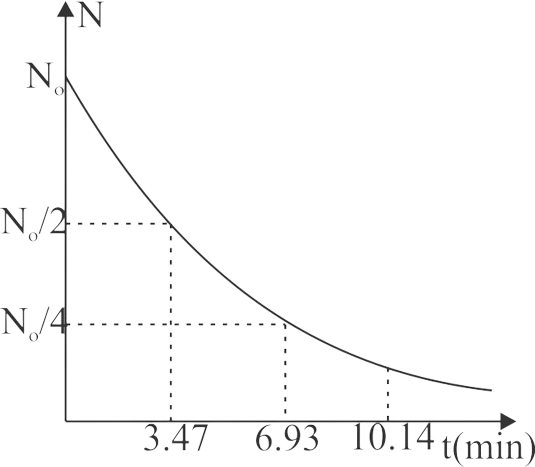363979 A small quantity of solution containing \(N{a^{24}}\) radio nuclide of activity 1 microcurie is injected into the blood of a person. A sample of the blood of volume \(1c{m^3}\) taken after 5 hours shows an activity of 296 disintegration per minute. What will be the total volume of the blood in the body of the person? Assume that the radioactive solution mixes uniformly in the blood of the person (Take 1 Curie \( = 3.7 \times {10^{10}}\) disintegration per second and \({e^{ - \lambda t}} = 0.7927;\) where \(\lambda = \) disintegration constant)
363979 A small quantity of solution containing \(N{a^{24}}\) radio nuclide of activity 1 microcurie is injected into the blood of a person. A sample of the blood of volume \(1c{m^3}\) taken after 5 hours shows an activity of 296 disintegration per minute. What will be the total volume of the blood in the body of the person? Assume that the radioactive solution mixes uniformly in the blood of the person (Take 1 Curie \( = 3.7 \times {10^{10}}\) disintegration per second and \({e^{ - \lambda t}} = 0.7927;\) where \(\lambda = \) disintegration constant)
363979 A small quantity of solution containing \(N{a^{24}}\) radio nuclide of activity 1 microcurie is injected into the blood of a person. A sample of the blood of volume \(1c{m^3}\) taken after 5 hours shows an activity of 296 disintegration per minute. What will be the total volume of the blood in the body of the person? Assume that the radioactive solution mixes uniformly in the blood of the person (Take 1 Curie \( = 3.7 \times {10^{10}}\) disintegration per second and \({e^{ - \lambda t}} = 0.7927;\) where \(\lambda = \) disintegration constant)
363979 A small quantity of solution containing \(N{a^{24}}\) radio nuclide of activity 1 microcurie is injected into the blood of a person. A sample of the blood of volume \(1c{m^3}\) taken after 5 hours shows an activity of 296 disintegration per minute. What will be the total volume of the blood in the body of the person? Assume that the radioactive solution mixes uniformly in the blood of the person (Take 1 Curie \( = 3.7 \times {10^{10}}\) disintegration per second and \({e^{ - \lambda t}} = 0.7927;\) where \(\lambda = \) disintegration constant)
363979 A small quantity of solution containing \(N{a^{24}}\) radio nuclide of activity 1 microcurie is injected into the blood of a person. A sample of the blood of volume \(1c{m^3}\) taken after 5 hours shows an activity of 296 disintegration per minute. What will be the total volume of the blood in the body of the person? Assume that the radioactive solution mixes uniformly in the blood of the person (Take 1 Curie \( = 3.7 \times {10^{10}}\) disintegration per second and \({e^{ - \lambda t}} = 0.7927;\) where \(\lambda = \) disintegration constant)

